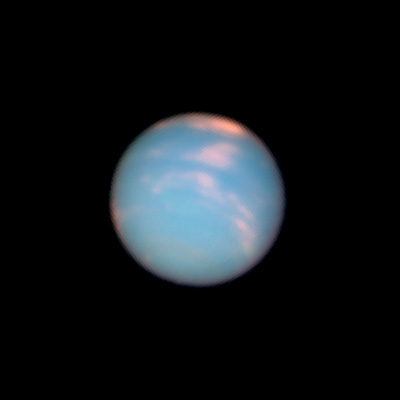How Far Away is Neptune?
The ice giant Neptune is the eighth and most distant planet from the sun. Since its discovery, only one Neptunian year has passed.

How far is Neptune from Earth?
The distance from one planet to another is constantly shifting because both bodies are moving through space. When Neptune and Earth line up on the same side of the sun, at their closest, they are only 2.7 billion miles (4.3 billon kilometers) apart. But when the planets are on opposite sides of the sun, they can put as many as 2.9 billion miles (4.7 billion km) between them.
Neptune's extreme distance made it the last full-size planet to be discovered. Unlike Uranus, it was found primarily by pouring over mathematical formulas rather than peering through a telescope. Astronomers had noticed that the recently-discovered Uranus had some orbital oddities that could not be explained. John Couch Adams and Urbain Le Verrier independently calculated the planet's orbit between 1845 and 1846, and several astronomers began to search for the proposed planet. On September 23, 1846, the icy body was found within one degree of Le Verrier's predictions and 12 degrees from where Adams suggested it would travel. This prompted discussion over who should be credited with the discovery, but ultimately both men were recognized for their roles.
The planet was spotted in 1612 and 1613 by Galileo Galilei. Unfortunately, the Italian astronomer made his observations when Neptune had just begun its backward, or retrograde, motion across the sky. Planets that lie farther from Earth occasionally appear to move backward when our planet passes them in their orbit. The enormous distance to Neptune meant that the motion was too small to record in Galileo's early telescope, resulting in his mischaracterization.
How far is Neptune from the sun?
Like all planets, Neptune orbits the sun in a stretched-out circle known as an ellipse. This means that its distance from the star is constantly changing. When the icy planet is closest to the sun, it lies "only" 2.77 billion miles (4.46 billion km). At its farthest, it passes 2.82 billion miles (4.54 billion km) from the star.
Although Neptune is the eighth most distant planet, it was not always. The dwarf planet Pluto occasionally dips inside of Neptune's orbit. Thus, when Pluto was classified as a planet, it was sometimes the eighth most distant planet while Neptune was the ninth. The two bodies will never collide, however, because for every three trips Neptune makes around the sun, Pluto takes exactly two, which keeps them from every traveling through the same area at the same time.
Neptune takes 164.79 Earth-years to travel around the sun. On July 11, 2011, Neptune had completed one full orbit since its discovery. It was not in the same spot in the sky, however, because Earth lay at a different point in its orbit.
Although the most distant planet now, it is possible the Neptune was not always so far away. The amount of gas and ice needed to form the giant planet is greater than fits current models. Some scientists suggest that Neptune may have formed closer to the sun, then migrated out to its present location over time.
How long does it take to reach Neptune?
The constant motion of Neptune and Earth is the biggest force that determines how long it takes to travel between the two planets. It would take a satellite longer to reach Neptune if it was launched when the two planets were on opposite sides of the sun instead of the same time.
The only spacecraft to visit Neptune was Voyager 2. Launched on August 20, 1977, it made its closest approach to the planet on August 25, 1989, after a dozen years of travel. Voyager 2 observed Neptune's "Great Dark Spot," a series of short-term storms in Neptune's atmosphere. The dark spot is approximately the same size as Earth, and is thought to be a hole in Neptune's methane clouds.
No other craft has traveled to the planet. However, NASA's New Horizons, launched January 19, 2006, will pass through Neptune's orbit on its way to visit Pluto and the Kuiper Belt. The spacecraft will travel through the planet's orbit in August of 2014, after eight years of traveling.
— Nola Taylor Redd, SPACE.com Contributor
Related:
Join our Space Forums to keep talking space on the latest missions, night sky and more! And if you have a news tip, correction or comment, let us know at: community@space.com.
Breaking space news, the latest updates on rocket launches, skywatching events and more!

Nola Taylor Tillman is a contributing writer for Space.com. She loves all things space and astronomy-related, and always wants to learn more. She has a Bachelor's degree in English and Astrophysics from Agnes Scott College and served as an intern at Sky & Telescope magazine. She loves to speak to groups on astronomy-related subjects. She lives with her husband in Atlanta, Georgia. Follow her on Bluesky at @astrowriter.social.bluesky
